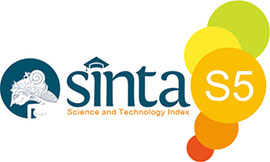INTEGRATION OF INFORMATION AND COMMUNICATION TECHNOLOGY IN LEARNING TO IMPLEMENTATION CURRICULUM 2013 AT JUNIOR HIGHSCHOOL IN KECAMATAN PADANG TIMUR
 ), Winanda Amilia(2), Hade Afriansyah(3),
), Winanda Amilia(2), Hade Afriansyah(3), (1) Universitas Negeri Padang
(2)
(3)
 Corresponding Author
Corresponding Author
DOI : https://doi.org/10.24036/et.v7i2.107500
Full Text:
 Language : en
Language : en
Abstract
Technology mastery is one of the most important competencies for teachers. In Permendiknas No. 16/2007 concerning Academic Qualification Standards and Teacher Competencies, there are four competencies that must be mastered by teachers, two of which are pedagogical and professional competencies. Both of these competencies are very closely related to the use of technology in learning. In curriculum 2013, every teacher is required to utilize technology in the learning process. This study aims to see the extent of the use of technology by teachers in the learning process in schools in Padang. This research is a field survey research. The subjects of this study were 60 public junior high school teachers in Padang. The research method used is quantitative descriptive percentage with data collection techniques in the form of a questionnaire in the form of a Likert scale of 5. The results obtained from this study are: (a) the use of information and communication technology by teachers in planning to get 70.1% results including the high category, (b) the use of information and communication technology by teachers in the learning process to obtain 69.1% results including high category, and (c) the use of information and communication technology in learning evaluation obtained 68.9% results included in the high category.
Keyword: information and communication technology, curriculum 2013
References
Amsal, M. F. (2015). PENGGUNAAN TEKNOLOGI KOMPUTASI AWAN (CLOUD COMPUTING) UNTUK KETERAMPILAN BERBICARA BAHASA INGGRIS SISWA SMA LABORATORIUM (PERCONTOHAN) UPI BANDUNG. Universitas Pendidikan Indonesia.
Anugrah, S., Andika, R., & Hendri, N. (2019). The Development of Augmented Reality- Based Learning Media to the Introduction of Computer Course in Curriculum and Educational Technology , Faculty of Education , Universitas Negeri Padang. 372(ICoET), 103–106.
Arikunto, S. (2010). Research procedure a practical approach. Jakarta: PT Rineka Reserved.
Brown, H. (2012). D.(2007). Principles of language learning and teaching. New York: Longman.
Daft, R. L. (2003). Manajemen Sumber Daya Manusia. Jakarta: Penerbit Erlangga.
Harjanto, D., & Pengajaran, P. (1997). Jakarta: PT. Rineka Cipta.
Hidayati, A., Amilia, W., & Amsal, M. F. (2017). Need analysis of media video development for character education at early childhood education in Padang. International Conference of Early Childhood Education (ICECE 2017). Atlantis Press.
Indonesia, R. (2013). Peraturan Menteri Pendidikan Dan Kebudayaan Republik Indonesia Nomor 65 Tahun 2013 Tentang Standar Proses Pendidikan Dasar Dan Menengah. Kemendikbud: Jakarta.
Krathwohl, D. R., & Anderson, L. W. (2009). A taxonomy for learning, teaching, and assessing: A revision of Bloom’s taxonomy of educational objectives. Longman.
Mulyasa, E. (2006). Kurikulum Berbasis Kompetensi, Konsep, Karakter, dan Implementasi. Bandung: PT. Remaja Rosdakarya.
Mulyasa, E. (2013). Pengembangan dan implementasi kurikulum 2013. PT Remaja Rosdakarya.
Muslich, M. (2007). KTSP: pembelajaran berbasis kompetensi dan kontekstual, panduan bagi guru, kepala sekolah, dan pengawas sekolah. Bumi Aksara.
Pendidikan, B. S. N. (2007). Permendiknas RI Nomor 41 tahun 2007 Tentang Standar Proses untuk Satuan Pendidikan Dasar dan Menengah. Jakarta: Depdiknas.
Pendidikan, P. M., & Nomor, K. (54AD). Tahun 2013 tentang Standar Kompetensi Lulusan Pendidikan Dasar dan Menengah. Peraturan Menteri Pendidikan Dan Kebudayaan No 81 Tahun 2013 Tentang Pendirian Satuan Pendidikan Norformal.
Rose, C., & Nicholl, M. (n.d.). J. 1997. Accelereted Learning For The, 21.
Rusman, K. (n.d.). Deni, dan Riyana, Cepi. 2011. Pembelajaran Berbasis Teknologi Informasi Dan Komunikasi. Jakarta: PT Raja Grafindo Persada.
Sudjana, N. (1988). Evaluasi Hasil Belajar. Bandung: Pustaka Martiana.
Sugiyono. (2008). Metode penelitian pendidikan:(pendekatan kuantitatif, kualitatif dan R & D). Alfabeta.
Taba, H. (1962). Curriculum development: Theory and practice.
Terry, G. R., & Rue, L. W. (2009). Dasar-dasar Manajemen, Edisi Bahasa Indonesia pada PT. Bumi Aksara, Jakarta, Alih Bahasa GA Ticoalu.
Uno, H. B. (2008). Teori motivasi dan pengukurannya. Jakarta: Bumi Aksara, 11–54.
 Article Metrics
Article Metrics
 Abstract Views : 242 times
Abstract Views : 242 times
 PDF Downloaded : 30 times
PDF Downloaded : 30 times
Refbacks
- There are currently no refbacks.





